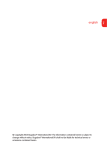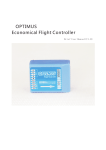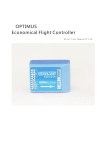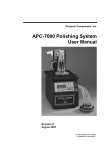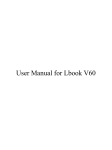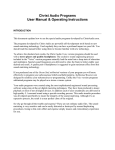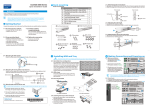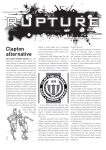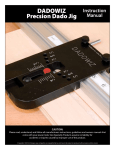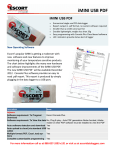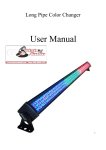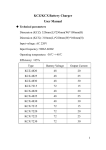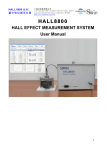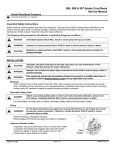Download SPEED ADDICT (SAFPV-Q-H) USER MANUAL REVISION 1
Transcript
CONTENTS 01 – BILL OF MATERIAL 02 – REQUIRED TOOLS 03 – BUILD PREPARATION 04 – LOWER SUBFRAME ASSEMBLY STEP 1 STEPS 2-3 (250mm Quad with 5” or 6” props) STEPS 2-3 (290mm Quad with 5” or 6” props) STEPS 2-3 (290mm Quad with 7” props) STEPS 2-3 (310mm Hex with 5” props) STEPS 4-6 05 – FUSELAGE ASSEMBLY AND JOINING THE FUSELAGE TO THE LOWER SUBFRAME STEPS 1-2 06 – TEAR OUT STOPS AND LANDING GEAR STEPS 1-2 07 – OPTIONAL “CLEAN SIDE” FUSELAGE FLIGHT CONTROLLER ASSEMBLY PROCEDURE STEPS 1-2 SECTION 01 BILL OF MATERIAL QUANTITY PART DESCRIPTION 1 Top Plate (Fuselage) 1 Bottom Plate (Fuselage) 1 Top Plate (Subframe) 1 Bottom Plate (Subframe) 1 CCD Camera Plate – 35mm 2 Subframe Stiffners 4 Arms for 250mm Quadcopter Configuration *If you purchased FULL KIT or 250mm quad only* 4 Arms for 290mm Quadcopter Configuration *If you purchased FULL KIT or 290mm quad only* 2 Arms for 310mm Hexacopter Configuration *If you purchased FULL KIT or 310mm hex only* 1 Lipo battery extended plate *If you purchased FULL KIT or 310mm hex only* 1 Catalyst Machineworks Power Distribution Board 12 Catalyst Machineworks Vibration Damper – Dual Head 8 Frame Standoffs – Black nylon M3 thread x 35mm long 2 Flight Controller Optional “Clean Side” Mount Tabs 8 Flight Controller Standoffs – Black nylon M3 thread x 10mm long x male and female ends 8 Flight Controller and Power Distribution Board Nuts– Black nylon M3 thread 4 Flight Controller Screws – Black nylon M3 thread x 6mm long x phillips head 4 Power Distribution Board Screws – Black nylon M3 thread x 8mm long x phillips head 4 Power Distribution Board M3 Frame Spacers x black nylon 4 Landing Gear Standoffs – Black nylon M3 thread x 20mm long x female ends 4 Landing Gear Feet – Black rubber 20 M3 Socket Head Screw x 10mm long x stainless steel 22 M3 Button Head Screw x 10mm long x stainless steel 22 M3 Socket Head Screw x 5mm long x stainless steel 28 M3 Nylock Nut x stainless steel 26 Washer M3 x aluminum 6 Frame Spacer x M3 x 4.5mm OD x aluminum 3 Tearout standoff M3 X10mm x aluminum 1 Large Side of Awesome Sauce SECTION 02 REQUIRED TOOLS QUANTITY TOOL DESCRIPTION 1 File 1 Sandpaper 1 2mm allen driver or allen wrench 1 2.5mm allen driver or allen wrench 1 5.5mm socket driver 1 Small phillips head screw driver 3 Adult beverage of choice SECTION 03 BUILD PREPARATION Build preparation involves rounding off the corners of all carbon fiber parts. This is not absolutely necessary to fly your Speed Addict but it is highly recommended and standard practice among top builders and racers. Catalyst Machineworks carbon fiber plate parts are cut by state of the art CNC machines. Cutting the raw material could leave a sharp edge on parts and it is possible this sharp edge could rub against wiring insulation, resulting in wiring shorts against the frame. Rounding the edges is quite easy to do, but does take some time as the process must be done with caution. Take your time and do it right, scratches on the flat surface will show. Keep that carbon fiber looking good! To round the edge of each part simply take a file or sanding block and hold the sanding edge at a 45º angle to the sharp edge. Work the sanding surface along the edge of the part until the sharp edge is gone. You want a smooth, rounded edge along the entire perimeter of the part and also any large open cutouts on the interior of a given part. It is not necessary to round small holes, such as screw holes, etc. SECTION 04 LOWER SUBFRAME ASSEMBLY GENERAL The Speed Addict frame is split up into two major assemblies. The Fuselage and Lower Subframe. It is designed to use an identical fuselage assembly between craft configuration types. In other words, the only difference between a 250mm quadcopter configuration and a 310mm hexacopter configuration is how the arms are assembled into the Lower Subframe. The only difference between a 250mm quadcopter and a 290mm quadcopter is the length of the arms. You can switch between craft configurations by altering the way the Lower Subframe is assembled. Longer arms can be inserted into the front and rear arm mounting locations. In addition, the rear arms can be rotated along a special slot to allow for larger props on the 290mm quadcopter configuration. Rotating the rear arms also allows for enough room to attach middle arms to the Lower Subframe for the 310mm hexacopter configuration. For the purposes of this manual we use the 250mm quadcopter craft configuration in the majority of the pictures. But, keep in mind that all other assembly processes beyond arm assembly steps are EXACTLY THE SAME for the other craft configurations. We will show pictures of all three craft configuration arm assembly steps including 250mm quadcopter, 290mm quadcopter, and 310mm hexacopter. STEP 1 The Speed Addict frame kit includes 12 Catalyst Machineworks special 10mm rubber 'ball' dampers. Insert the dampers into the top plate of the subframe assembly, one by one. To do this position one side of the top lip of the damper over the frame hole. Push and work the damper into the hole until the lip of the damper pops through the hole. You can use a small tool (like an allen driver) to better facilitate this, but take your time - try not to damage the damper or the frame surface if you choose to use a tool. STEP 2 (250mm Quad with 5” or 6” props) The following assembly procedure applies to a 250mm quad configuration using either 5” or 6” props. Locate and then sandwich the 2 rear arms at the rear of the frame between the lower subframe bottom and top plates. Insert 6 M3 x 10mm socket head screws into the holes shown below. Three screws are used per arm. Next flip the subframe over and install a washer and nut onto each screw. Torque down the nut and screw until secured and very tight, these are important and a vital component to the structural integrity of the finished product. STEP 3 (250mm Quad with 5” or 6” props) Slip the two front arms between the top and bottom plate. Align the holes and insert M3 x 10mm socket head screws as shown below, 2 screws per arm. Next flip the subframe over and install a washer and nut onto each screw. Torque down the nut and screw until secured and very tight, these are important and a vital component to the structural integrity of the finished product. STEP 2 (290mm Quad with 5” or 6” props) The following assembly procedure applies to a 290mm quad configuration using either 5” or 6” props. Locate and then sandwich the 2 rear arms at the rear of the frame between the lower subframe bottom and top plates. Insert 6 M3 x 10mm socket head screws into the holes shown below. Three screws are used per arm. Next flip the subframe over and install a washer and nut onto each screw. Torque down the nut and screw until secured and very tight, these are important and a vital component to the structural integrity of the finished product. STEP 3 (290mm Quad with 5” or 6” props) Slip the two front arms between the top and bottom plate. Align the holes and insert M3 x 10mm socket head screws as shown below, 2 screws per arm. Next flip the subframe over and install a washer and nut onto each screw. Torque down the nut and screw until secured and very tight, these are important and a vital component to the structural integrity of the finished product. STEP 2 (290mm Quad with 7” props) The following assembly procedure applies to a 290mm quad configuration using either 7” props. Locate and then sandwich the 2 rear arms at the rear of the frame between the lower subframe bottom and top plates. Insert 6 M3 x 10mm socket head screws into the holes shown below. Three screws are used per arm. Then flip the subframe over and install 1 washer and 1 nut per screw. Torque down the nut and screw until secured and very tight, these are important and a vital component to the structural integrity of the finished product. STEP 3 (290mm Quad with 7” props) Slip the two front arms between the top and bottom plate. Align the holes and insert M3 x 10mm socket head screws as shown below, 2 screws per arm. Next flip the subframe over and install a washer and nut onto each screw. Torque down the nut and screw until secured and very tight, these are important and a vital component to the structural integrity of the finished product. STEP 2 (310mm Hex with 5” props) The following assembly procedure applies to a 310mm hexacopter configuration using either 5” props. Locate and then sandwich the 2 rear arms at the rear of the frame between the lower subframe bottom and top plates. Insert 4 M3 x 10mm socket head screws into the holes shown below. Two screws are used per arm. Then flip the subframe over and install 1 washer and 1 nut per screw. Torque down the nut and screw until secured and very tight, these are important and a vital component to the structural integrity of the finished product. STEP 3 (310mm Hex with 5” props) Slip the two front arms between the top and bottom plate. Align the holes and insert M3 x 10mm socket head screws as shown below, 2 screws per arm. Then flip the subframe over and install 1 washer and 1 nut per screw. Torque down the nut and screw until secured and very tight, these are important and a vital component to the structural integrity of the finished product. Slip one middle arm between the top and bottom plates and align holes as shown. Insert 2 M3 x 10mm socket head screws and 1 M3 x 10mm button head screw as shown. Place a subframe stiffener between the head of the screw and the top plate. Then flip the subframe over and install 2 washers and 3 nuts as shown. Torque down the nut and screw until secured and very tight, these are important and a vital component to the structural integrity of the finished product. Install another M3 x 10mm button head screw and subframe stiffener as shown, while passing the screw though the plates position a M3 x 4.5mm frame spacer inline. Finally install a nut and torque down. Install another middle arm to the opposite side of the frame using 2 M3 x 10mm socket head screws and 2 M3 x 10mm button head screws. Be sure to pass the screws through the holes on the frame stiffeners. While passing the front screws though the plates position a M3 x 4.5mm frame spacer inline. Finally install 2 washers and 4 nuts and torque down. STEP 4 (All craft configurations) Place a M3 x 4.5mm frame spacer between the top and bottom subframe plates at the rear of the frame. Then use a tool to slide the spacer inline with the open hole at the rear of the frame. (The spacer and corresponding hole are highlighted by red circles in the photo below.) Once the frame spacer is inline insert a M3 x 10mm socket head screw, washer, and nut. Torque down the nut and screw. There is another hole in the front of the subframe that needs a M3 x 10mm socket head screw, M3 x 4.5mm frame spacer, washer, and nut. Locate this hole then insert the spacer between the top and bottom plates of the subframe. Then use a tool to slide the spacer inline with the open hole at the front of the frame. (The spacer and corresponding hole are highlighted by red circles in the photo below.) Once the frame spacer is inline insert a M3 x 10mm socket head screw, washer, and nut. Torque down the nut and screw. STEP 5 (All craft configurations, EXCEPT for 310mm hex) Place 2 M3 x 4.5mm frame spacers between the top and bottom subframe plates. Then use a tool to slide the spacers inline with the open holes at the sides of the frame. The spacers and holes are called out with red circles below. Once the frame spacers are inline insert 2 M3 x 10mm button head screws and 2 nuts. Torque down the nuts and screws. Use the same procedure, fastener types, and fastener quantities for the opposite side of the subframe. Once complete, your subframe should look like the pictures below. STEP 6 (All craft configurations) Install 4 black nylon M3 phillips head screws, and 4 Power Distribution Board M3 Frame Spacers into the PDB mounting slots. One screw and one spacer, per slot. *PLEASE NOTE* If you prefer to setup your Speed Addict frame with the flight controller on the “clean side” fuselage instead of the “dirty side” Lower Subframe, jump ahead to section 7 of this manual for specific instructions. Once all of your wiring is soldiered to the PDB we suggest to clean the PDB bottom with rubbing alcohol. Then cut strips of black electrical tape and adhere them to the bottom of the board, completely covering it. The black tape is extra insurance to protect against a possible short if something conductive were to make its way between the PDB and the carbon fiber plate of the subframe. Carbon fiber is conductive! Now that your PDB's bottom surface is properly insulated install it onto the subframe as shown below. Thread 4 M3 X 10mm black nylon flight controller standoffs into the screws as shown below. Apply enough torque to firmly hold the assembly in place but not too much as to strip the nylon threads. Thread 4 more M3 X 10mm black nylon flight controller standoffs into the existing standoffs, as shown below. Apply enough torque to firmly hold the assembly in place but not too much as to strip the nylon threads. Your flight controller will be mounted onto the standoffs as shown below. Install 4 nylon nuts. Apply enough torque to firmly hold the assembly in place but not too much as to strip the nylon threads. SECTION 05 FUSELAGE ASSEMBLY & JOINING TO SUBFRAME STEP 1 (All craft configurations) Fasten 8 M3 X 35mm black nylon frame standoffs using 8 M3 X 10mm button head screws to the bottom fuselage plate in the locations shown below. Apply enough torque to firmly hold the standoff in place but not too much as to strip the nylon threads. Position the camera plate between the fuselage top and bottom plates in the designated slots as in the picture below. The camera plate must be oriented in a specific way. Insert the camera plate so the proper side is facing up. The red arrow in the picture below shows which side should be “up”. Make sure to position the camera plate in the fuselage so this side is indeed, up. With the camera plate's four tabs inserted into the frame plates slots install 2 M3 X 10mm button head screws into the front two frame standoffs. Next install 6 more M3 X 10mm button head screws through the top frame plate into the standoffs. Apply enough torque to firmly hold the standoff in place but not too much as to strip the nylon threads. STEP 2 (All craft configurations) Now it is time to join the fuselage to the lower subframe. This is done by inserting all 12 dampers into the mating holes in the fuselage, one by one. To do this position one side of the top lip of each damper over the frame hole. While using your hand to compress the fuselage down into the subframe push and work the damper into the hole until the lip of the damper pops through the hole. You can use a small tool (like an allen driver) to better facilitate this, but take your time - try not to damage the damper or the frame surface if you choose to use a tool. Another trick to get the lip of the damper through the hole is to work to get one corner of the lip through, then take your finger and tug at the lip until the rest of it pops through. SECTION 06 TEAROUT STOPS & LANDING GEAR STEP 1 (All craft configurations) Assemble 3 tearout stops as shown below. Use 1 M3 x 10mm aluminum standoff, 1 washer, and 1 M3 x 5mm socket head screw per tearout stop. Install one tearout stop at each of the three corners of the frame as shown below. One in the rear and one on either side. Use 2 M3 X5mm socket head screws per tearout stop. And 3 aluminum washers as shown below. Its is very important to “sandwich” the frame plate between two washers as shown below. This gives extra durability during hard crashes and spreads forces and stress on a larger area of carbon fiber. STEP 2 (All craft configurations) Assemble 4 landing gear as shown below. Use 1 rubber end cap and 1 M3 x 20mm black nylon standoff per landing gear foot. Install each landing gear foot into the hole on each arm as shown below. Use 1 M3 X 10mm button head screw per foot. Apply enough torque to firmly hold the foot in place but not too much as to strip the nylon threads. Now your unbelievably awesome Speed Addict FPV racing frame is done. Sit back and revel in its awesomeness - you have created a piece of fine art, something you can be proud of, something you can show your parents to prove that you really DO want to be a professional FPV racer when you grow up. Remember this day; it is one of your finest. Stay tuned to www.catalystmachineworks.com for new and upcoming accessories and gizmos for your Speed Addict FPV addiction. SECTION 07 OPTIONAL “CLEAN SIDE” FLIGHT CONTROLLER INSTALL STEP 1 (All craft configurations) Install 4 black nylon M3 phillips head screws, and 4 Power Distribution Board M3 Frame Spacers into the PDB mounting slots. One screw and one spacer, per slot. Once all of your wiring is soldiered to the PDB we suggest to clean the PDB bottom with rubbing alcohol. Then cut strips of black electrical tape and adhere them to the bottom of the board, completely covering it. The black tape is extra insurance to protect against a possible short if a foreign object were to make its way between the PDB and the carbon fiber plate of the subframe. Carbon fiber is conductive! Now that your PDB's bottom surface is properly insulated install it onto the subframe as shown below. Next install 4 black nylon nuts. Apply enough torque to firmly hold the PDB in place but not too much as to strip the nylon threads. STEP 2 (All craft configurations) Install 2 “clean side” mount tabs as shown below using a total of 4 M3 X 10mm button head screws and 4 nylock nuts. Next install a total of 4 M3 X 10mm black nylon flight controller standoffs and 4 M3 X 6mm black nylon phillips head screws. Your flight controller is fastened using 4 nylon nuts.

























































